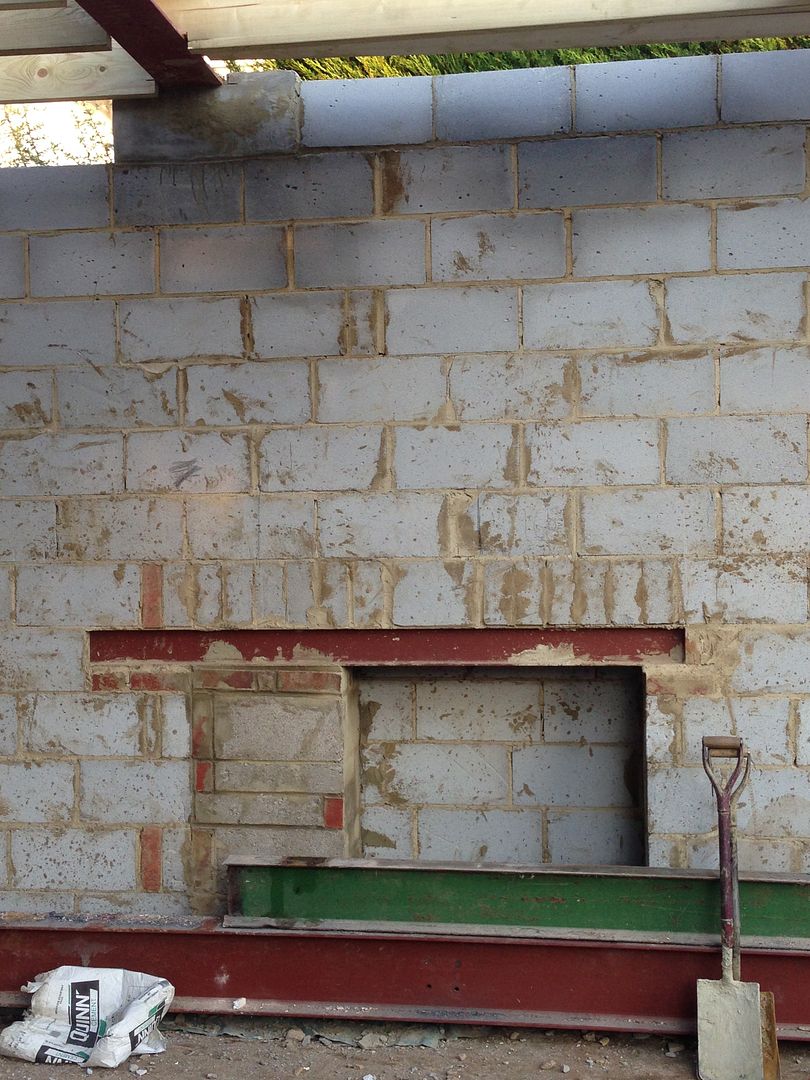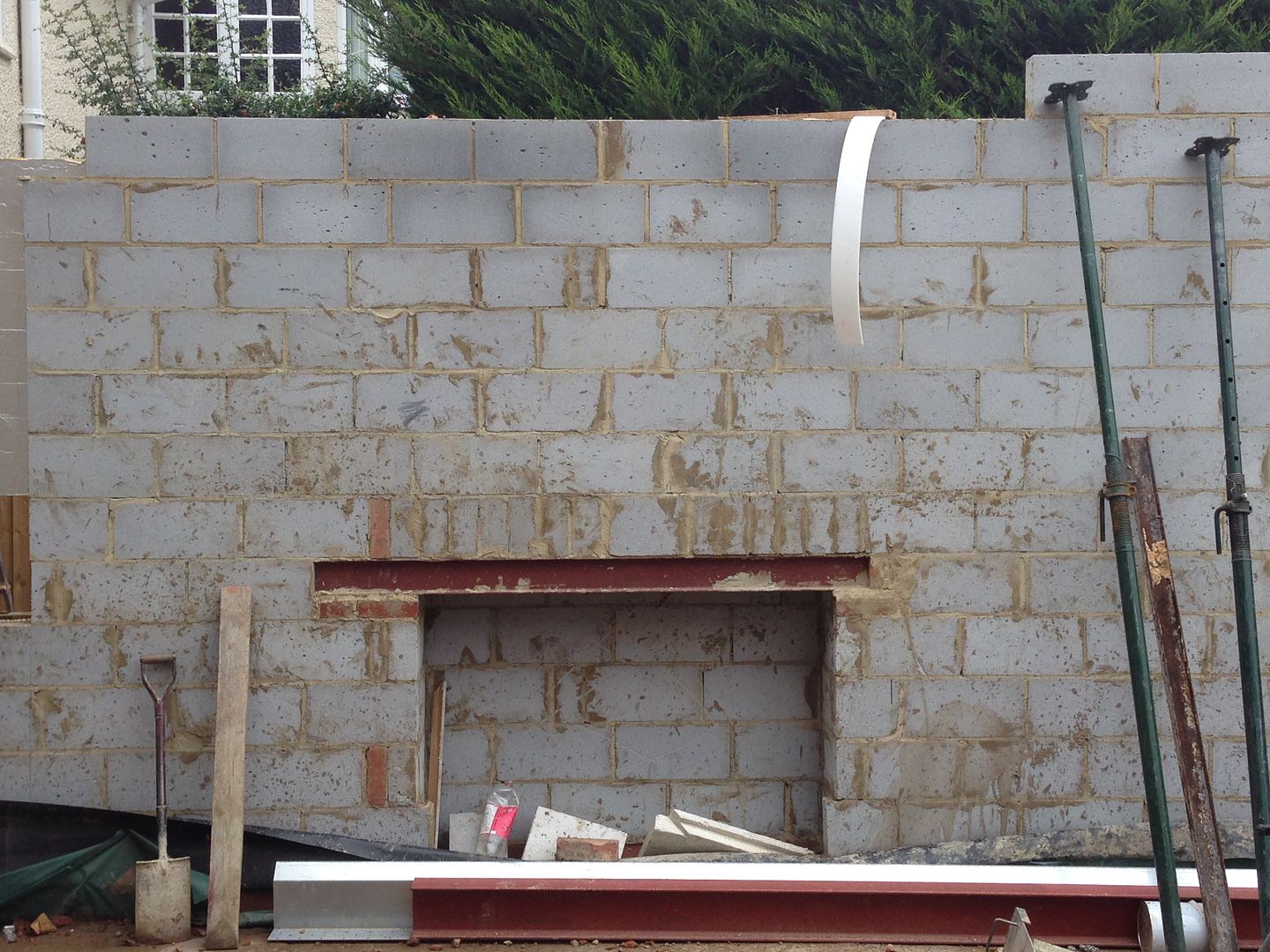You are using an out of date browser. It may not display this or other websites correctly.
You should upgrade or use an alternative browser.
You should upgrade or use an alternative browser.
Strength of thermalite blocks
- Thread starter ey143
- Start date
Sponsored Links
As long as there are suitable padstones to spread the load at the bearing, the Thermalite will be fine to support the loads you describe.
Having said that, the bearing at the right-hand side looks shorter than would be expected, but should still be OK. Why is the beam not centred over the opening?
Having said that, the bearing at the right-hand side looks shorter than would be expected, but should still be OK. Why is the beam not centred over the opening?
Why is the beam not centred over the opening?
Looks like they've just gone with the bond to save cutting a piece on the left. Nothing wrong with that.
We're actually going to make the opening smaller as we cant now install the 1400mm wide stove we wanted (not Defra approved) and so will go with a 900mm one.
The reason I ask the question, is because a HETAS stove installer made the comment to me when he saw the wall and was surprised that the padstones have been installed the way they have because of the weight etc bearing down onto the wall. My builder didn't like that comment when I asked him that and said that the guy should STFU and not comment on other trades....builder says its according to the structural engineer's drawings.
But it just got me thinking as to why use these light weight blocks to hold that beam you see on the floor, but will go horizontally from the chimney wall to another centre beam (box frame) to support the weight above. Builder has used concrete blocks for the inside wall going from ground level all the way to the loft to create partitions and load bearing walls.
The reason I ask the question, is because a HETAS stove installer made the comment to me when he saw the wall and was surprised that the padstones have been installed the way they have because of the weight etc bearing down onto the wall. My builder didn't like that comment when I asked him that and said that the guy should STFU and not comment on other trades....builder says its according to the structural engineer's drawings.
But it just got me thinking as to why use these light weight blocks to hold that beam you see on the floor, but will go horizontally from the chimney wall to another centre beam (box frame) to support the weight above. Builder has used concrete blocks for the inside wall going from ground level all the way to the loft to create partitions and load bearing walls.
Sponsored Links
said that the guy should STFU and not comment on other trades....builder says its according to the structural engineer's drawings.
Lol. That's good advice from your builder.
Millions of houses and flats have been built with these blocks and beams, and chimneys, flues, fireplaces .....
said that the guy should STFU and not comment on other trades....builder says its according to the structural engineer's drawings.
Millions of houses and flats have been built with these blocks and beams, and chimneys, flues, fireplaces .....
Even fire places? Several other HETAS engineers who came before the latest one said that you need concrete blocks or 50 Newton blocks due to the heat from the stove. Those thermalite blocks you see also have 50mm celotex boards attached to them in the cavity. So was wondering about heat issues and cracking on the blocks even though we will put in a clay liner.
said that the guy should STFU and not comment on other trades....builder says its according to the structural engineer's drawings.
Millions of houses and flats have been built with these blocks and beams, and chimneys, flues, fireplaces .....
Even fire places? Several other HETAS engineers who came before the latest one said that you need concrete blocks or 50 Newton blocks due to the heat from the stove. Those thermalite blocks you see also have 50mm celotex boards attached to them in the cavity. So was wondering about heat issues and cracking on the blocks even though we will put in a clay liner.
Big difference between a concrete block (7-10N/mm2) and an engineering brick at 50N/mm2 but what the heck; do the calcs if it bothers you. Your thermalite blocks will either be 3.6 or 7.2 N/mm2. Let's say they are the weaker ones, and they're 440 long by 100 thick: 440 X 100 X 3.6 = 158400. To convert Newtons into tons we divide by 9800 (force of earth's gravity, times a thousand kg in a ton), so that's about 16.2 tons. Said another way, take your weak thermalite block, put a suitable load spreader on top, and then balance two JCB 3CX diggers (about 8 tons) on top of it and it's on the limit of being crushed
But what does your builder/structural engineer know(/assume liability for) in the face of the wisdom(/no liability) of the fire installer
Everything is stronger than you think, and buildings are lighter than most ever appreciate
But what does your builder/structural engineer know(/assume liability for) in the face of the wisdom(/no liability) of the fire installer
Everything is stronger than you think, and buildings are lighter than most ever appreciate
Newtons is a measure of compressive strength. Nothing to do with heat. Those blocks are made of concrete.
How hot do you expect the area around the stove to be? Are you making pottery?
A stove will typically reach between 180 and 250 degrees. The question about strength is just for my curiosity on the subject as this is not my subject area. The question about heat is a more serious one. I've had a few HETAS people saying no way Jose for using themalite blocks but one HETAS guy saying ok but not ideal. Given the temperatures I mention, can Quinn themalite blocks take this sort of heat (dont forget that the stove will reach that temperature but I dont know how much less hot the surrounding areas are).
Updated pic with the padstone and beam now installed and the opening reduced in width.

I've had a few HETAS people saying no way
What evidence or standard did they cite to support their statement? And why did they just mention the blocks and not the mortar too, which is just as important in accommodating thermal movement? Or even that steel beam?
Steel beam was also mentioned too....should have been concrete ideally but too late now so HETAS guy said just leave 15-20mm either side for expansion.
But ideally. We'd to know thermal expansion on that beam to be accurate.
The rest I don't know the answers to your question, that's why I posted here to see if more knowledgable folk know.
But ideally. We'd to know thermal expansion on that beam to be accurate.
The rest I don't know the answers to your question, that's why I posted here to see if more knowledgable folk know.
The bottom line is that you don't need specific blocks around a log burner.
If the HETAS engineer thinks otherwise, then he needs to provide evidence of the standard he is referring to. If the steel beam is lined with a cement board product, then that should minimise any expansion
If the HETAS engineer thinks otherwise, then he needs to provide evidence of the standard he is referring to. If the steel beam is lined with a cement board product, then that should minimise any expansion
- Joined
- 1 May 2021
- Messages
- 1
- Reaction score
- 0
- Country

Did this all turn out okay in the end? Just had some work done myself and fascinating to see how light and airy the thermolite is.
I'm curious to know how strong thermalite blocks are. Is it normal for them to become load bearing walls and take the weight of an RSJ to accommodate a second storey room and a loft room above?
What about heat from a fire place stove?
DIYnot Local
Staff member
If you need to find a tradesperson to get your job done, please try our local search below, or if you are doing it yourself you can find suppliers local to you.
Select the supplier or trade you require, enter your location to begin your search.
Please select a service and enter a location to continue...
Are you a trade or supplier? You can create your listing free at DIYnot Local
Sponsored Links
Similar threads
- Replies
- 8
- Views
- 4K
- Replies
- 31
- Views
- 14K

